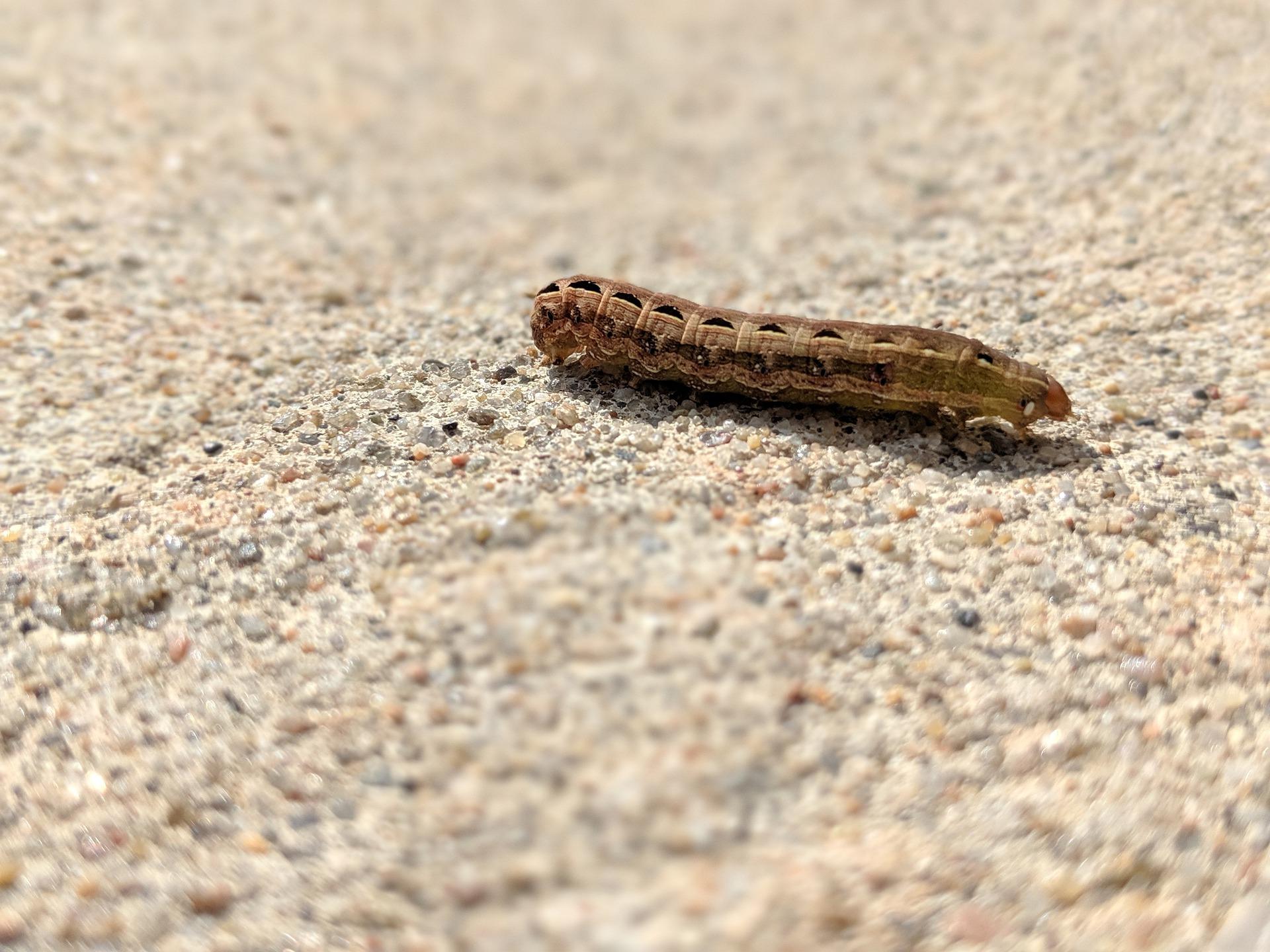Plants cut off at the soil line is symptom of cutworms

Photo: W.M. Hantsbarger, Bugwood.org
Appearance
- Eggs: Tiny, white-brown spheres (black cutworm) or half-spheres (variegated cutworm), with ribs radiating from center, laid on foliage in clusters of up to several hundred.
- Larvae: Stout caterpillars with rough skin, almost 2” long when full grown (there are usually 6 instars). Black cutworm: uniformly gray/brown to nearly black, somewhat greasy sheen. Variegated cutworm: brownish/gray to grayish/black with yellow-white spots on its back and a dark “W” mark on its 8th abdominal segment of last instar (growth stage).
- Pupae: Dark brown/mahogany colored case, ¾ - 1” long, in a chamber near soil surface.
- Adults: Moths with up to 2" wingspan. Black cutworm: wings uniformly dark brown with black “dash” marking on forewing. Variegated cutworm: wings grayish/brown with darker bean-shaped spot and smaller round spot usually visible on each wing.


Photo: Merle Shepard, Gerald R.Carner, and P.A.C Ooi, Insects and their Natural Enemies Associated with Vegetables and Soybean in Southeast Asia, Bugwood.org
Life cycle/habits
- Cutworms are important early-season pests of vegetable crops in Maryland.
- They typically overwinter as pupae, with additional adult moths migrating in from the south in spring.
- Adult moths feed on nectar from flowers and lay eggs on foliage.
- Early instar (life stage) larvae may feed during the day, but larger larvae feed at night and seek shelter during the day in soil or elsewhere.
- Young larvae begin feeding on foliage in early May.
- Older larvae feed near the soil surface, cutting off young plants at or below ground surface and sometimes pulling them underground to consume.
- Larvae are also defoliators and may feed on fruits, roots, and tubers as well.
- Variegated cutworms readily climb trees to feed on buds, foliage and even tree fruit.
- Cutworms curl up when disturbed.
- There are several generations a year.

Host plants
- Extremely wide host plant range. Primarily tomato and corn, but also feed on asparagus, beans, beet, brassicas, broccoli, cantaloupe, carrot, celery, collards, cucumber, eggplant, lettuce, okra, onion, peas, pepper, potato, radish, rhubarb, spinach, squash, sweet potato, turnip and watermelon, plus tree fruits, and small fruits.
Signs/symptoms
- Seedlings or even transplants are cut off at the soil line or disappear entirely at night (dragged underground into cutworm burrows).
- Feeding damage appears on foliage, fruit, or buds, often without any pest visible during the day.
- Variegated cutworms may tunnel into tomatoes or cabbage and cauliflower heads.
- Cutworms may feed on storage roots or tubers, making smooth cavities.
Monitoring
- Watch for seedlings cut off at the soil line or disappearing altogether at night. The first generation of mature cutworm larvae does the most damage.
Prevention/control
- Most feeding injury is superficial and can be ignored.
- In spring or fall, till soil to disrupt possible overwintering sites, exposing pests to predators and freezing temperatures.
- Larger transplants better withstand damage. Pre-sprouting seeds is also helpful.
- Floating row cover prevents egg-laying and excludes larvae.
- Protect seedlings with a 3" cardboard, foil or plastic collar pushed into soil around plant stems.
- Discourage cutworms with coarse materials such as crushed oyster shell, sand, or diatomaceous earth, placed around plant stems.
- Handpick larvae, and either crush them or drop them into a container of soapy water.
- Bacillus thuringiensis (Bt), an organic pesticide, will kill young larvae.
 English
English العربية
العربية Български
Български 简体中文
简体中文 繁體中文
繁體中文 Hrvatski
Hrvatski Čeština
Čeština Dansk
Dansk Nederlands
Nederlands Suomi
Suomi Français
Français Deutsch
Deutsch Ελληνικά
Ελληνικά हिन्दी
हिन्दी Italiano
Italiano 日本語
日本語 한국어
한국어 Norsk bokmål
Norsk bokmål Polski
Polski Português
Português Română
Română Русский
Русский Español
Español Svenska
Svenska Català
Català Filipino
Filipino עִבְרִית
עִבְרִית Bahasa Indonesia
Bahasa Indonesia Latviešu valoda
Latviešu valoda Lietuvių kalba
Lietuvių kalba Српски језик
Српски језик Slovenčina
Slovenčina Slovenščina
Slovenščina Українська
Українська Tiếng Việt
Tiếng Việt Shqip
Shqip Eesti
Eesti Galego
Galego Magyar
Magyar Maltese
Maltese ไทย
ไทย Türkçe
Türkçe فارسی
فارسی Afrikaans
Afrikaans Bahasa Melayu
Bahasa Melayu Kiswahili
Kiswahili Gaeilge
Gaeilge Cymraeg
Cymraeg Беларуская мова
Беларуская мова Íslenska
Íslenska Македонски јазик
Македонски јазик יידיש
יידיש Հայերեն
Հայերեն Azərbaycan dili
Azərbaycan dili Euskara
Euskara ქართული
ქართული Kreyol ayisyen
Kreyol ayisyen اردو
اردو বাংলা
বাংলা Bosanski
Bosanski Cebuano
Cebuano Esperanto
Esperanto ગુજરાતી
ગુજરાતી Harshen Hausa
Harshen Hausa Hmong
Hmong Igbo
Igbo Basa Jawa
Basa Jawa ಕನ್ನಡ
ಕನ್ನಡ ភាសាខ្មែរ
ភាសាខ្មែរ ພາສາລາວ
ພາສາລາວ Latin
Latin Te Reo Māori
Te Reo Māori मराठी
मराठी Монгол
Монгол नेपाली
नेपाली ਪੰਜਾਬੀ
ਪੰਜਾਬੀ Afsoomaali
Afsoomaali தமிழ்
தமிழ் తెలుగు
తెలుగు Yorùbá
Yorùbá Zulu
Zulu ဗမာစာ
ဗမာစာ Chichewa
Chichewa Қазақ тілі
Қазақ тілі Malagasy
Malagasy മലയാളം
മലയാളം සිංහල
සිංහල Sesotho
Sesotho Basa Sunda
Basa Sunda Тоҷикӣ
Тоҷикӣ O‘zbekcha
O‘zbekcha አማርኛ
አማርኛ Corsu
Corsu Ōlelo Hawaiʻi
Ōlelo Hawaiʻi كوردی
كوردی Кыргызча
Кыргызча Lëtzebuergesch
Lëtzebuergesch پښتو
پښتو Samoan
Samoan Gàidhlig
Gàidhlig Shona
Shona سنڌي
سنڌي Frysk
Frysk isiXhosa
isiXhosa